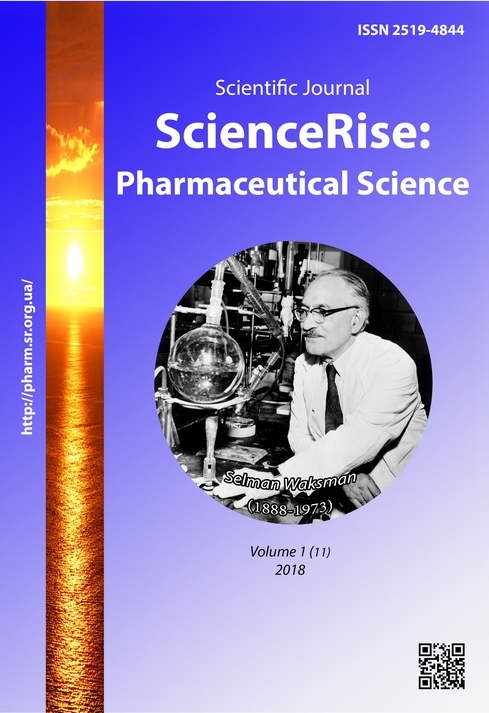Актуальні підходи до розробки нових антимікробних засобів в умовах поширення явища антибіотикорезистентності
DOI:
https://doi.org/10.15587/2519-4852.2018.122169Ключові слова:
антимікробні засоби, наночастинки металів, інфекційні захворювання, резистентність мікроорганізмів, елімінація плазмідАнотація
Мета. Обґрунтування доцільності вивчення характеру взаємодії наночастинок металів з плазмідною ДНК бактерій на етапі фармацевтичної розробки антимікробних засобів на основі наночастинок металів як самостійних антимікробних агентів, а також композицій наночастинок металів з відомими антимікробними речовинами.
Методи. Використано методи інформаційного пошуку та аналізу даних літератури.
Результати. Плазмідна передача стійкості до лікарських засобів є найбільш важливим механізмом виникнення резистентності в бактеріальній популяції. Перспективним підходом до вирішення проблеми подолання резистентності мікроорганізмів є застосування в якості активних фармацевтичних інгредієнтів антимікробних засобів речовин, які будуть викликати деструкцію R–плазмід або забезпечувати їх незворотну елімінацію. Вивчення взаємодії речовин з плазмідною ДНК бактерій та дослідження їх впливу на передачу генів резистентності в бактеріальних популяціях доцільно застосовувати на першому етапі створення антимікробних лікарських засобів, на якому проводиться вибір потенційного активного фармацевтичного інгредієнта.
Висновки. Створення та впровадження у виробництво лікарських засобів на основі наночастинок срібла та золота є перспективним напрямком, оскільки наночастинки даних металів поряд з антимікробною дією будуть забезпечувати незворотну елімінацію плазмід з бактеріальних клітин та можуть стати вирішенням проблеми антибіотикорезистентності
Посилання
- O’Neill, J. (2014). Antimicrobial resistance: tackling a crisis for the health and wealth of nations. HM Goverment, 16. Available at: https://amr-review.org/Publications.html
- WHOs first global report on antibiotic resistance reveals serious, worldwide threat to public health (2014). Available at: http://www.who.int/mediacentre/news/releases/2014/amr-report/en/
- Global action plan on antimicrobial resistance. WHO. Available at: http://www.wpro.who.int/entity/drug_resistance/resources/global_action_plan_eng.pdf
- The FAO action plan on antimicrobial resistance 2016–2020. Rome: Food and Agriculture Organization of the United Nations (2016). Available at: http://www.fao.org/3/a-i5996e.pdf
- World Antibiotic Awareness Week. World Health Organization. Available at: http://www.who.int/publications/en/
- Bondarchuk, I. (2016). Natsionalna stratehiia borotby z rezystentnistiu do antybiotykiv v Ukraini. Apteka, 40 (1061). Available at: http://apteka.ua/article/387723
- Rezystentnost mykroorhanyzmov y puty ee preodolenyia. Available at: http://nsau.edu.ru/images/vetfac/images/ebooks/microbiology/stu/bacter/ecologia/rezistmo.htm
- Bondar, M. V., Pylypenko, M. M., Svintukovskyi, M. Yu., Kharchenko, L. A., Prevysla, O. M., Tsvyk, I. M. (2016). Antybiotykorezystentnist mikroorhanizmiv: mekhanizmy rozvytku ta shliakhy zapobihannia. Medytsyna neotlozhnykh sostoianyi, 3 (74), 11–17.
- Fursova, N. K. (2012). Lekarstvennaia ustoichyvost mikroorhanyzmov. Shchelkovo: Yzdatel Markhotyn P. Yu., 248.
- Fleming, A. (1945). Penicillin (Nobel lecture). Available at: https://www.nobelprize.org/nobel_prizes/medicine/laureates/1945/fleming-lecture.pdf
- Savchenkova, L., Lukianchuk, V. (2005). Problema antybyotykorezystentnosty v sovremennoi medytsyne. Visnyk farmakolohii ta farmatsii, 1, 2–7.
- Chekman, I. (2007). Antybiotyky: problemy efektyvnosti ta ratsionalnoho vykorystannia. Visnyk farmakolohii ta farmatsii, 8, 24–27.
- Shyrobokov, V. (2007). Antybiotyky: oderzhannia ta zastosuvannia. Visnyk farmakolohii ta farmatsii, 8, 19–23.
- Kolbyn, A. S., Balykyna, Yu. E., Sydorenko, S. V. (2010). Issledovanyia y razrabotky (R&D) novykh antybakteryalnikh sredstv. Est ly ohranychenyia v etom napravlenii? Remedyum, 12. Available at: http://remedium-journal.ru/arhiv/detail.php?ID=41641&num=%B912&sec_id=4637
- Uvarova, Yu. (2010). Rynok antybakteryalnikh preparatov systemnoho yspolzovanyia. Remedyum, 6. Available at: http://remedium-journal.ru/arhiv/detail.php?ID=36401&num=%B96&sec_id=4291
- WHO global strategy for containment of antimicrobial resistance (2001). Geneva: WHO, 105. Available at: http://www.who.int/drugresistance/WHO_Global_Strategy_English.pdf
- VOOZ zminyla klasyfikatsiiu antybiotykiv i onovyla perelik likarskykh zasobiv (2017). Vashe zdorovia, 25-26. Available at: http://www.vz.kiev.ua/vooz-zminyla-klasyfikatsiyu-antybiotykiv-i-onovyla-perelik-likarskyh-zasobiv/
- Tsymbalista, O. L. (2017). Problema rezystentnosti mikroorhanizmiv do antybiotykiv. Sovremennaia pedyatryia, 2 (82), 52–56.
- Ulberh, Z. R., Hruzina, T. H., Dybkova, S. M. et. al. (2010). Biobezpechni nanochastynky metaliv v nanomedytsyni ta nanobiotekhnolohii. Visnyk problem biolohii ta medytsyny, 4, 72–77.
- Piminova, A. F. (Ed.) (2014). Nanotekhnologii v farmatsii i meditsine. Vol. 2. Kharkiv: Fakt, 820.
- Chekman, I. S. (2011). Nanofarmakolohiia. Kyiv: Zadruha, 424.
- Dybkova, S. M., Ulberh, Z. R., Hruzina, T. H., Reznichenko, L. S. (2017). Pat. No. 118364 UA. Zastosuvannia nanochastynok zolota abo sribla yak ahentiv eliminatsii plazmid antybiotykorezystentnosti. MPK (2017.01), A61K 33/24 (2006.01), A61K 33/38 (2006.01). No. u 2016 13262; declareted: 26.12.2016; published: 10.08.2017, Bul. No. 15, 4.
- Dybkova, S. M., Reznichenko, L. S., Rybachuk, A. V. et. al. (2017). Pat. 118412 UA. Sposib podolannia antybiotykorezystentnosti mikroorhanizmiv – zbudnykiv infektsiino-zapalnykh protsesiv shchelepno-lytsevoi dilianky. MPK (2017.01), G01N 33/569 (2006.01), A61K 33/00. No. u 2017 01147; declareted: 07.02.2017; published: 10.08.2017, Bul. No. 15, 4.
##submission.downloads##
Опубліковано
Як цитувати
Номер
Розділ
Ліцензія
Авторське право (c) 2018 Svіtlana Bilous, Svitlana Dуbkova, Olga Liutko, Liudmyla Rieznichenko, Tamara Gruzina, Tymofiy Kalyniuk

Ця робота ліцензується відповідно до Creative Commons Attribution 4.0 International License.
Наше видання використовує положення про авторські права Creative Commons CC BY для журналів відкритого доступу.









